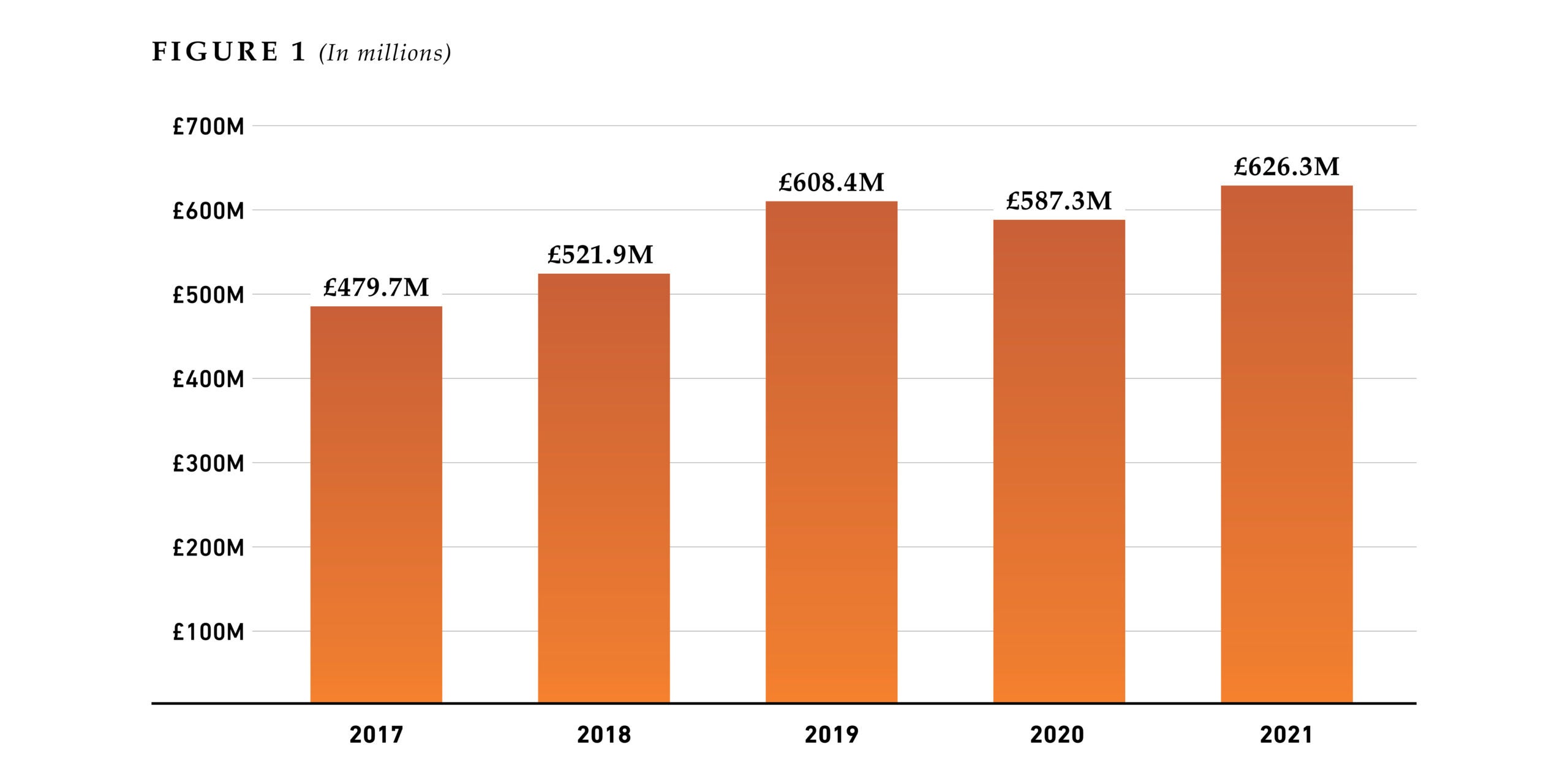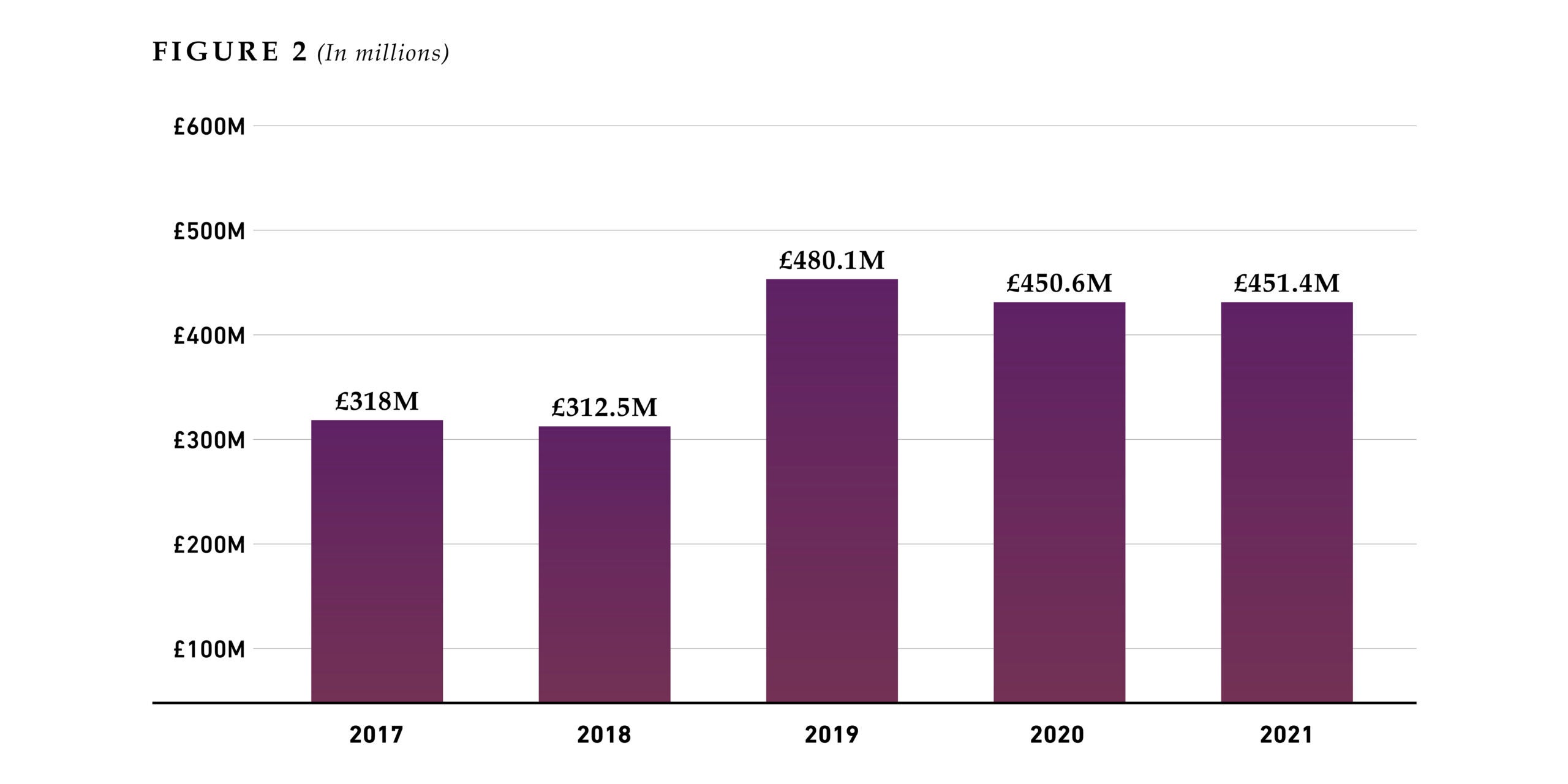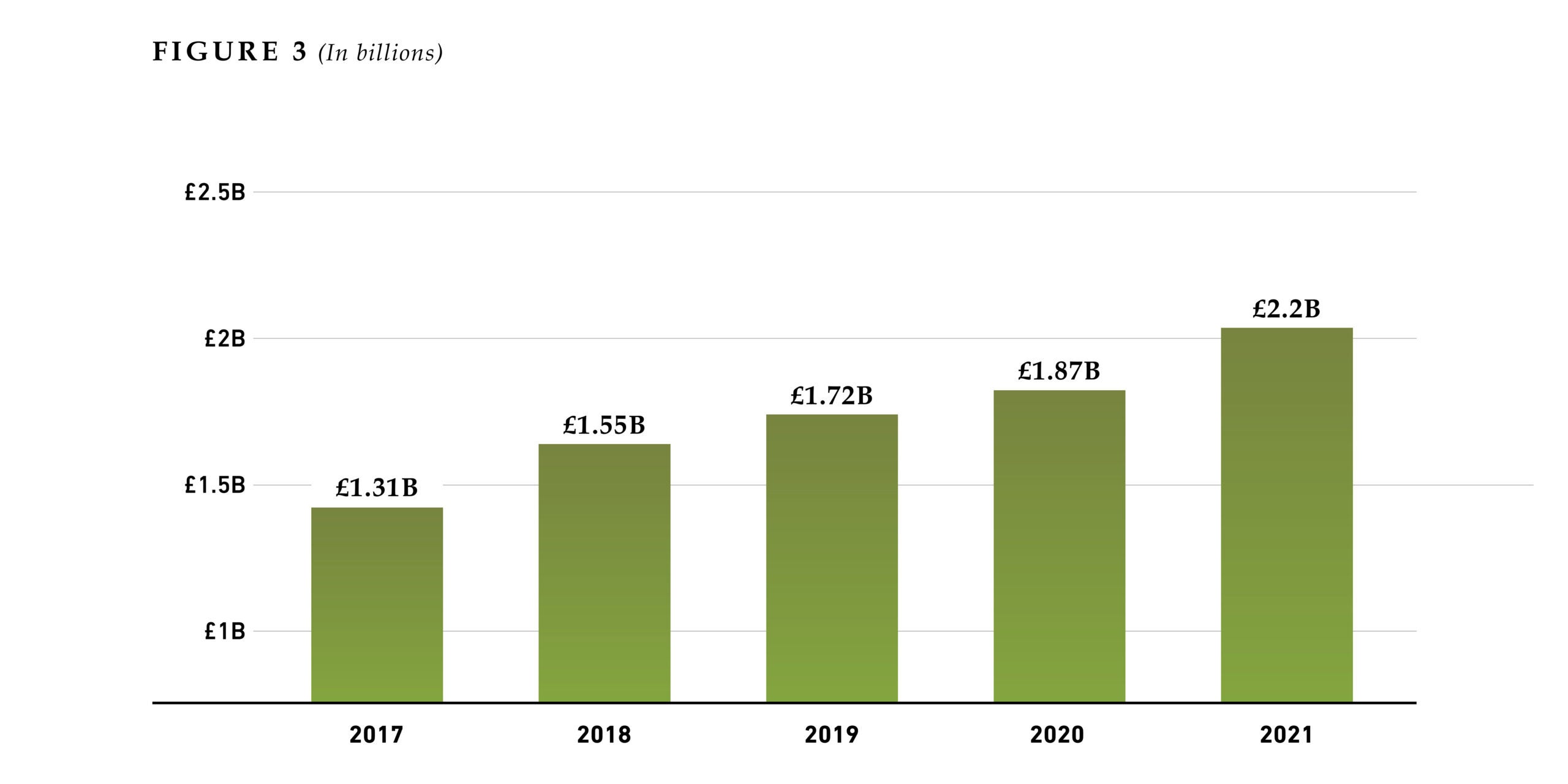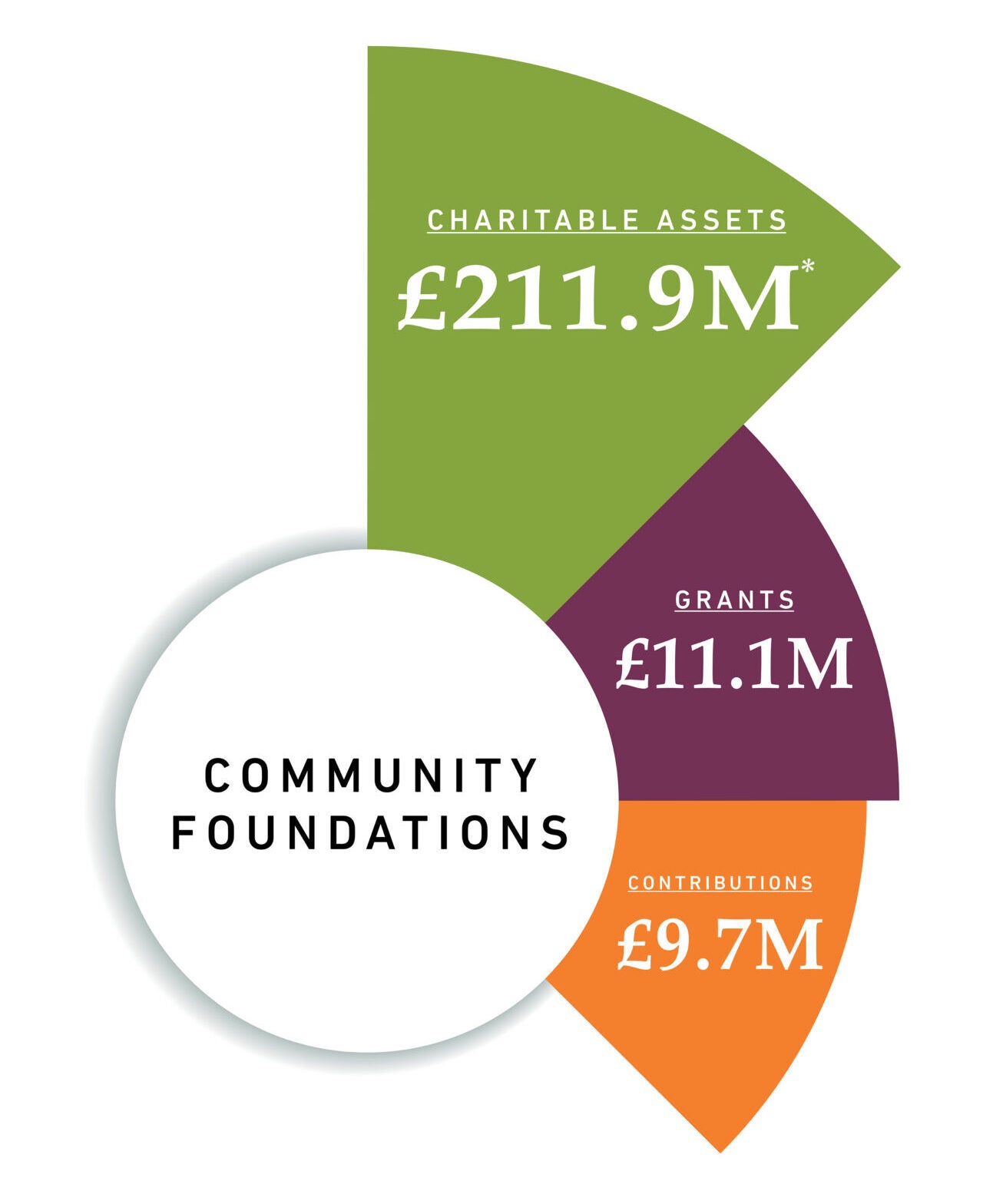National Philanthropic Trust UK is pleased to publish our seventh annual UK Donor-Advised Fund Report.
A donor-advised fund (DAF) is a philanthropic fund established under an umbrella charity which administers the DAF account on behalf of the donor. A donor makes an irrevocable charitable contribution, receives immediate tax relief, and then recommends charitable grants from the DAF account over time. The donor also recommends how the charitable assets are invested before being granted out.
Our 2022 UK Donor-Advised Fund Report examines data from 2017 to 2021 from UK charities that offer donor-advised funds. The findings confirm that donor-advised funds continue to play an important role in UK philanthropy. DAF donors respond — quickly and generously — in the face of pressing problems. This edition of the UK Donor-Advised Fund Report is noteworthy in that it captures the charitable response to the second year of the COVID-19 pandemic.
In 2021:
- Contributions to donor-advised funds were £626.3 million, or a 6.7 per cent increase, compared with the prior year’s contributions.
- Charitable assets in donor-advised funds total £2.2 billion—an increase of 20 per cent over the prior year.
- The aggregate grant payout rate from donor-advised funds was 24 per cent in 2021, versus 26 per cent in 2020.
- Grants from donor-advised funds to other charities were £451.4 million, a slight increase of 0.18 per cent over the prior year.
As awareness of these giving vehicles grows in the UK, donors and their advisors increasingly use donor-advised funds as the modern alternative to establishing a grantmaking charitable trust or foundation. Since every pound in donor-advised fund accounts is destined for charitable organisations, the rise in donor-advised funds is good news for British charities and charities around the world that receive grants from DAFs.
John Canady
CEO
A Glossary of Terms
Charitable Assets
The amount charitable sponsors hold and manage in donor-advised fund accounts. Some charitable sponsors manage other types of funds as well. This report is limited to assets in donor-advised fund accounts.
Charitable Organisation
A charity. In the context of this report, a charitable organisation can be either a charitable sponsor of donor-advised funds or the recipient of a donor-advised fund grant. A UK charitable organisation is registered at the Charity Commission and a foreign charitable organisation is eligible to receive grants from the UK according to HMRC and Charity Commission regulations. Donations to a charitable organisation are eligible for tax relief. A charitable organisation serves broad public purposes in educational, religious, scientific, and artistic fields, among others, as well as social wellbeing and other public benefit activities.
Charitable Sponsor
A charitable organisation that manages donor-advised fund accounts. Charitable sponsors provide services to ensure that potential grant recipients are qualified charitable organisations and administer donor-advised fund accounts to ensure compliance with all regulations. Also called sponsoring charity, fund sponsor, or umbrella charity.
Contribution
Amount a donor donates to a donor-advised fund account when establishing the fund or adding money to it.
Donor-Advised Fund
A philanthropic giving vehicle administered by a charitable sponsor. A donor-advised fund allows donors to establish and fund the account by making irrevocable, tax-relieved contributions to the charitable sponsor. Assets in the account are invested based on the donors’ recommendations. Donors then recommend grants from those funds to other qualified charitable organisations.
Grant
A transfer of assets from a donor-advised fund account to a qualified charitable recipient.
Market Overview
In 2021, total estimated charitable giving in the UK was £10.7 billion, according to the CAF UK Giving Report. In this edition of the UK Donor-Advised Fund Report we analyse giving to and from DAFs, one type of charitable giving vehicle, for fiscal year 2021. Charities operate on different fiscal year periods, which means the reporting period began as early as 1 May 2020 for some charities and ended as late as 31 December 2021 for others.
Contributions to DAFs totalled £626.3 million in 2021, which equates to 5.9 per cent of total individual giving in the UK.
This period was still dominated by COVID-19, with another national lockdown announced in England just days into the year. Schools and non-essential shops closed for several months, and restrictions were not finally lifted until July after the roll-out of the vaccine programme.
Economic indicators play an important role in charitable giving. In 2021, the overall UK economy grew, as businesses reopened during the pandemic. Gross domestic product increased year-on-year by 7.5 per cent.1 The stock market increased significantly during 2021 with the FTSE 100 growing by over 14 per cent.2 Unemployment declined to 4 per cent3 as of December 2021, after beginning the year at 5.1 per cent.4 Personal income, also adjusted for inflation, rose by 2 per cent.5
In response to the events noted above and their far-reaching impacts, grants from DAFs rose in 2021, as did contributions, and total charitable assets.
1Office for National Statistics (ONS), released 31 May 2022, ONS Website – GDP quarterly national accounts, UK: October to December 2021
2Reuters – FTSE 100 posts biggest annual gains in five years December 31, 2021
3Office for National Statistics (ONS), released 15 February 2022, ONS Website – Employment in the UK: October to December 2021
4Office for National Statistics (ONS), released 23 February 2021, ONS Website – Employment in the UK: October to December 2020
5Office for National Statistics (ONS), released 28 March 2022, ONS Website Average household income, UK: financial year ending 2021
Contributions at All-Time High
Contributions to donor-advised funds in 2021 totalled £626.3 million, an increase of 6.7 per cent. The compound annual growth rate was 7 per cent for contributions from 2017 to 2021.

Grants Total £451 Million
Grants from donor-advised funds to charitable organisations totalled £451.4 million. The compound annual growth rate from 2017 to 2021 was 9 per cent.

Charitable Assets Pass £2 Billion
Charitable assets under management in all donor-advised funds totalled over £2.2 billion in 2021, an all-time high. This is a 20 per cent growth rate compared to 2020. The compound annual growth rate for charitable assets from 2017 through 2021 was 14 per cent.

Observations and Projections
Looking back on 2021, all key metrics increased – contributions, grants, and charitable assets under management.
Contribution growth was driven by donors continuing to focus on the COVID-19 response and donors who made contributions to their DAFs to prepare for sustained grantmaking to charities facing pressure on their funding from other sources. Contributions increased in response to significant stock market growth.
Grants increased slightly in 2021, reflecting donors who made grants from their DAFs to support the charities facing pressure on their funding from other sources. The increase in value of charitable assets as markets strengthened also provided more money available for grantmaking from the DAFs.
What Lies Ahead?
We expect growth in donor-advised funds given that donors are searching for more structured approaches to manage their charitable giving and are increasingly using DAFs as an alternative to setting up their own charity, charitable trust, or foundation. We also expect growth as donor-advised fund awareness increases amongst the wealth managers, lawyers, and accountants who advise philanthropists.
Based on our own experience and observed trends at our peer charitable organisations, we have seen an increase in contributions of non-cash assets. For example, donors who contribute appreciated shares receive two tax benefits: the gifted shares are not liable for capital gains tax (CGT), and the donor can also claim income tax relief for the market value. We anticipate that donors will increasingly donate non-cash assets to donor-advised funds in the coming years.
We have also seen a rise in the use of donor-advised funds to ensure regulatory compliance. Regulations – particularly around trustee responsibilities and grantmaking due diligence – are constantly evolving. Using a donor-advised fund ensures that a donor is assured of regulatory compliance with the latest regulations.
We have also seen international donors using UK donor-advised funds to manage their philanthropy and cross-border giving.
We expect growth to continue because donor-advised funds are convenient and can be used as a giving tool in so many ways: by different generations, across different geographies, and on all time horizons.
Summary
Donor-advised funds continue to grow in all key metrics. Due to restatements in Stewardship’s financial statements we saw a drop in contributions from 2019 to 2020 to donor-advised funds. Grants from donor-advised funds have grown at a compound annual growth rate of 9 per cent between 2017 and 2021. Donor-advised funds are becoming well-established as effective giving vehicles for active donors who want to support their favourite charities.
Methodology
Organisations
This report examined thirteen charities registered at the Charity Commission of England and Wales that sponsor donor-advised funds.
Primary Data Sources
The primary source for each charitable sponsor’s assets, contributions, and grants is the organisation’s Annual Report filed with the Charity Commission of England and Wales.
Secondary Sources
The following served as secondary sources for the above data and cited statistics:
- CAF UK Giving 2022, Charities Aid Foundation
- Filings at Companies House
- The organisations’ websites
- Survey responses from Charitable Sponsors, including:
- Charities Aid Foundation
- Charities Trust
- C. Hoare & Co, the Master Charitable Trust
- Prism the Gift Fund
- SharedImpact
- Stewardship
- UBS UK Donor-Advised Foundation
- UK Community Foundations
Projections are based on National Philanthropic Trust UK’s experience and anecdotal evidence over the past year, in addition to observed economic and political conditions.
Standard Fiscal Data by Filing Year
Since organisations have varied financial year-end dates, data was recorded in the filing year. For example, whether an organisation’s fiscal year ends on 31 March 2020 or 31 December 2020, the data will be recorded as 2020.
Payout Calculation
Payout from donor-advised funds is calculated as the current year’s grants divided by charitable assets held at the end of the prior year.
DAFs and Community Foundations
A community foundation is a charity with a long-term goal of engaging many separate donors to carry out charitable interests for the benefit of residents of a defined geographic area. Amongst other charitable programmes and services, community foundations often offer donor-advised funds. As such, they are a specific type of Charitable Sponsor. In the UK, there are 47 community foundations. This report contains DAF data from the 16 community foundations who provided data for fiscal year 2021.
*Represents 45 per cent of total charitable assets held at all UK community foundations. This data was not included in the overall report because historical data was unavailable. As reporting by the community foundations continue, we hope to include this data in the report totals in the future.
Acknowledgements
This report was prepared by National Philanthropic Trust UK in collaboration with Cath Dovey, an independent consultant and co-founder of the Beacon Collaborative, which seeks to increase the level of philanthropy and social investment in the UK. Oliver Nicholl-Dovell provided data analysis and research assistance.
National Philanthropic Trust UK gratefully acknowledges all of the organisations that shared their donor-advised fund statistics and information.
